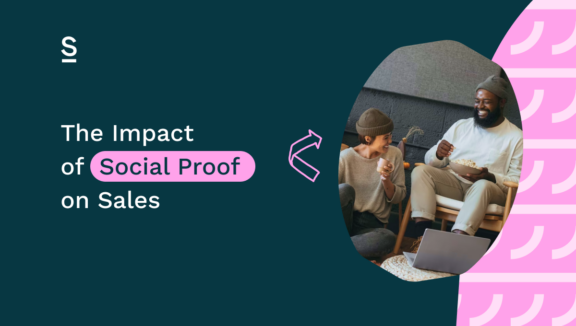The Impact of Social Proof on Sales

When was the last time you were faced with a really big decision?
What career path to take. What car to buy. Whether to sell all your possessions and move to Peru.
Whatever it was, how did you make up your mind? Unless you’re a coin-flipper, we bet you started by doing some research.
Checking out the Glassdoor of the company that offered you a job. Diving into a Reddit thread about the car you considered. Asked your backpacking friend what their six months in South America were like.
When people don’t know what to do, they often look to people around them to help them decide. And decision-makers in the world of B2B sales are no different.
That’s why companies that use testimonials on their website see a 34% increase in conversions. And why 92% of B2B buyers are more likely to make a purchase after reading a trusted review.
Think of social proof as the secret to better selling strategies and, ultimately, more sales.
Want to learn more? We’ll be covering:
- Understanding social proof
- The power of testimonials in sales
- How case studies help you convert
- Implementing social proof in sales strategies
- How to get social proof for your business
- Measuring the impact of social proof
Let’s get started 👇
Understanding Social Proof in Sales
Social proof is the brainchild of Robert Cialdini, who started writing about it way back in 1984. In a nutshell, people copy other people – particularly in situations where they’re unsure what to do.
Looking to others helps individuals become more confident in their decision-making. It’s another way that people feel they belong and can conform to social norms.
Let’s apply this psychological theory to marketing and sales. If potential customers know that other people use and like the product they’re considering, they’re more likely to make a purchase. Boom.
Types of social proof
So, what does social proof look like in the wonderful world of B2B?
- Testimonials: a quotation or quantitative result from a customer
- Case studies: a deep dive into the problem a customer faced, and how your product solved it
- Influencer endorsements: yes, these are a thing even in B2B! Creators on LinkedIn can work much the same way as your favourite Instagram or TikTok star
- Social media: if your company has a load of followers, or gets hundreds of shiny comments on every post, it’s more likely to seem legit
- Customer logos: even just the logo of a famous brand can do wonders for your business
- Integrations: these work especially well for newer businesses – partnering up with a bigger player indicates legitimacy
- Press mentions: press mentions indicate a business is legit, and a respected voice in the industry
A lot of these, like influencer marketing or press mentions, impact decision-making further up the funnel. That’s not to say they’re not important (the opposite, in fact – they help leads find their way to you).
That said – mentioning you’ve paid an influencer to use your product may impact your brand recognition, but it probably isn’t going to swing it when it comes down to the final decision post-demo.
Instead, social proof really comes into its own for the sales process in the form of testimonials and case studies. Let’s take a closer look.
The Power of Testimonials in Sales
Testimonials are one of the most vital types of social proof – for the simple reason that we can use them throughout the sales funnel.
Using the voice of satisfied customers helps to build trust in your brand. If you say your product will ‘save loads of time’ – big deal, so does every other business out there. Having a customer back you up by explaining it’s saved them 5 hours of admin time a week, on the other hand, is far more effective.
Testimonials are also pretty short by nature – a standout quote, or an impressive success metric, for example. That makes them easy to ask for, and easy to understand.
How case studies help you convert
Case studies – like testimonials, but in a longer format – help you to convert your prospects in much the same way that testimonials do. They build trust in your brand, and as a bonus point, they also help your customers relate to what you do.
Digging into the problem you solve, and bringing it to life with real-person examples, is really going to help your prospects see themselves in your clients. And what do people do when they relate to someone? They copy them 😉
Implementing Social Proof in Sales Strategies
So, how can we use our precious social proof in our sales strategies?
Honestly, the sky’s the limit – think of a customer touchpoint, and you’ll probably be able to use social proof to your advantage there.
A well-placed statistic or mention of a famous customer can work wonders in an outreach email – or you might want to talk through a case study in a pitch, and follow up with a PDF version. Meanwhile, your marketing team should have them all over your public channels; your website, your socials, and so on.
How to get social proof for your business
Each business will have different ways of getting social proof – it largely depends on your setup and what your customer relationships are like. Different approaches to try include:
- Personal reach-outs: if you have a great relationship with a client, you or your CS equivalent should reach out to ask directly. People are less likely to let you down if they know you personally and love the service you provide.
- Automated surveys: these can be a quick, no-strings approach to getting shorter testimonials or customer quotes. Keep them to a couple of questions max – the easier, the better.
- Social media engagement: if your following is on the larger side, keep an eye on your comments and see if there are any you could repurpose. This also works well if you use a review site like Trustpilot – just remember to ask permission first.
- Incentives: we’re not going to suggest you start paying customers for good reviews, but paying them for an honest review is a great way to keep your social proof coming regularly.
Tip: we’d recommend giving guidance here where you need it. If you’re filming a case study, send questions covering an introduction, the challenge, the solution and the results in advance. If you’re asking for a review, give them some questions designed around what you’d most like to hear as a starting point.
Another tip (full of them today, aren’t we): think about how to repurpose each piece of social proof you receive. A case study can be a written piece on your blog, a video on your socials, a quote on your homepage and a metric on your sales one-pager, for example.
A note on authenticity
Fake social proof is bad practice – and plenty of businesses have paid for it in bad press and a damaged brand reputation.
If you’re pulling social proof from your reviews platform, for example, always cross-reference the information (try to find the customer who left the review in your CRM), and double check the profile looks legit.
If you’re caught out using a fake review – whether it was an accident, or not – it’s not going to help you in the long run. Be careful and be honest, and you’ll reap the rewards.
Likewise, take a second to consider any metrics you’re publishing. It’s important not to overdo the claims you’re making – people just won’t believe you if the numbers are too high. Sharing the average impact your product makes can be a good move here.
Measuring the impact of social proof
As with any sales tactic, there’s just no point in introducing it and then promptly forgetting about it. Getting social proof can be a lot of work – you don’t want to put it all to waste by not checking if it’s impactful or not.
Key sales metrics you want your social proof to impact are:
- Website conversion rate: putting social proof on your website should have a positive impact on businesses booking a demo call or signing up for your product. Other metrics to keep an eye on include dwell time and click-through rate
- Sales cycle length: this could be one part of the funnel – including statistics in your outreach, for example – or the funnel as a whole. If it goes down, your social proof is working
- Customer acquisition cost: the less you spend on acquiring customers, the more you know your brand has trust and credibility. Thank you, social proof!
It’s important to define the impact you’re hoping to make before you start introducing a new social proof initiative. You can use tools like your CRM to track the data and display it in an easy-to-digest way – from there, it’s simply a matter of using the data to inform your next steps. Rinse and repeat.
Let’s say you’ve managed to get a fantastic case study out of your most famous customer. You put a quote on your website – but nothing really changes. Next, you could try tweaking its position on the page, changing the format in which it’s displayed (could it be a video clip instead of text, for example), or adding it to your blog as well. Eventually, you should hit the sweet spot and have your website conversions start to increase.
Keeping the mindset of continuous improvement is key here. There’s always more to be done with the content you have – and don’t forget that you’ll need to update the content itself too. If you’re still banging on about a testimonial from a customer that churned last year, for example, you’re not helping future you. Go easy – future you will appreciate it.
Let’s wrap it up!
Did we just try and give you social proof for the concept of social proof?
Whatever – our head hurts just thinking about that. In short, social proof works, and you should be using it.
Focus on getting impactful quotations and metrics in multiple formats like text, long-form and video, and you’ve got a wealth of opportunity in front of you. Your prospects will start trusting your brand and understanding why they should buy from you (because people like them have already done so 😉).
And that will lead to them sliding down the sales funnel faster than you hop on a flight to Peru. Not that you’ll need to do that, being so successful at your job and everything.

Ready to dazzle new leads with social proof? Here’s how to find them.
Surfe makes prospecting on LinkedIn a breeze – it finds contact data, automatically migrates it to your CRM and keeps everything up to date. Oh, and did we mention it’s free?


